

Bioinformatics. Lab-Grown Organs and Tissues. Synthetic & Systems Biology. Synthetic Biology. Biotech Politics. Models. General Recombinant DNA Tech. Gene Therapy. Transgenic Crops. Cyborg Tissues. Stuff from my classes. Remote Triggered Genes. DNA Repair Earned the Nobel Prize in Chemistry, and Here's Why. Taking plants off planet – how do they grow in zero gravity? Gravity is a constant for all organisms on Earth.
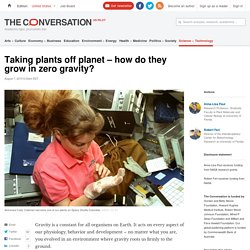
Abnormal IVF embryos can now be predicted within 30 hours of development. The chromosomal abnormalities that affect at least half of the human embryos created for in vitro fertilisation (IVF) can now be predicted within the first 30 hours of development at the cell-1 stage - days before they need to be transferred into a woman's body.
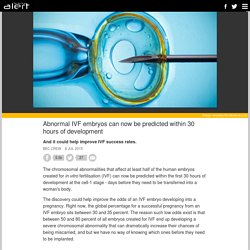
The discovery could help improve the odds of an IVF embryo developing into a pregnancy. Right now, the global percentage for a successful pregnancy from an IVF embryo sits between 30 and 35 percent. The reason such low odds exist is that between 50 and 80 percent of all embryos created for IVF end up developing a severe chromosomal abnormality that can dramatically increase their chances of being miscarried, and but we have no way of knowing which ones before they need to be implanted.
Transgenic Pigs Shatter Transplant Records. With the financial aid of a biotechnology executive whose daughter may need a lung transplant, U.S. researchers have been shattering records in xenotransplantation, or between-species organ transplants.
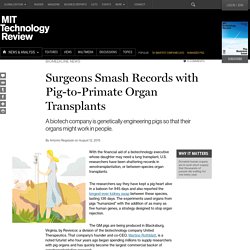
The researchers say they have kept a pig heart alive in a baboon for 945 days and also reported the longest-ever kidney swap between these species, lasting 136 days. Blumsy comments on Transplantability of a circadian clock to a noncircadian organism. This Is Why Wasabi Sets Your Mouth On Fire. A single taste is enough to make you unforgettably familiar with the effects of wasabi, but why does it happen?

The reason is this protein right here — and it has some major implications for how we treat pain. David Julius and Yifan Cheng of The University of California San Francisco created this 3D model — the first ever — of receptor TRPA1, better known as the "wasabi receptor", the protein responsible for giving wasabi its bite. Scientists Have Transplanted Mammoth DNA Into Elephant Cells. A lot of people seem to be under the misconception that scientists want to clone mammoths to restore a wild population.
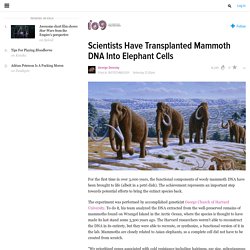
No scientist is advocating for that; their environment doesn't exist any more. The first cloned mammoths would be used purely for research, and we're quite a ways off from mass cloning. One day we could borrow ‘antifreeze’ proteins from ticks to resist cold. These pests might be good for something after all.
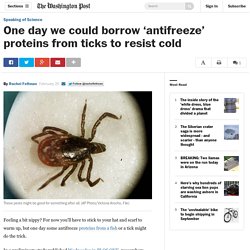
(AP Photo/Victoria Arocho, File) Feeling a bit nippy? For now you'll have to stick to your hat and scarf to warm up, but one day some antifreeze proteins from a fish or a tick might do the trick. In a preliminary study published Wednesday in PLOS ONE, researchers report using specially bred mice -- ones spliced with the genes that give ticks antifreeze cells -- to show that mammals can benefit from the proteins that other species use to keep from icing over.
Ticks aren't the only species with so-called antifreeze proteins, which help keep creatures that don't moderate their own body temperatures from ending up with frozen cells (or, in some cases, just keep that freezing from having harmful effects) by preventing the formation of ice crystals inside tissue. This Biohacker Used Eyedrops To Give Himself Temporary Night Vision. Goddamn that sounds like a great time!

My wife would rather stab aforementioned pipet into her eye than undertake a trip like this but man, i'd love to do that some day! Flagged To make it extra awesome, I jump on an off-road dirt bike (no lights) and go ride out on the hardpan during these stary nights. Away from the campfire, and out in the middle of the flats there is zero point of reference while you ride, just a lighter colored expanse below you with tiny gypsum crystals that reflect the starlight above. Scientists Recreate a Really Sad Greek Myth With Worms. Zeus, king of the gods, victor over the titans, father to god knows how many illegitimate children, and slave to the Furies.

Man With Severed Spinal Cord Walks Again After Cell Transplant. A man paralyzed for two years is now walking again, albeit with a frame, after a transplant to his spine.

The treatment, to be published in this month's Cell Transplantation, has been under discussion for a while, but has only now shown success. In 2010, Darek Fidyka was repeatedly stabbed, rendering him paralyzed from the chest down. Fortunately, however, his nose was unscathed. A Medical First: Woman Successfully Gives Birth With A Donated Womb. "women the world over with missing or non-functional uteruses" I had no idea this was even a thing.
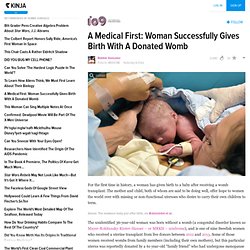
I'm one of those women thanks to a massive fuck-up by a NYC gynecologist when I was 19. My niece has this same syndrome. No uterus, but she does have ovaries, so she went through puberty. Broad-Spectrum Anti-biofilm Peptide That Targets a Cellular Stress Response. Abstract Bacteria form multicellular communities known as biofilms that cause two thirds of all infections and demonstrate a 10 to 1000 fold increase in adaptive resistance to conventional antibiotics. Currently, there are no approved drugs that specifically target bacterial biofilms. Here we identified a potent anti-biofilm peptide 1018 that worked by blocking (p)ppGpp, an important signal in biofilm development.
At concentrations that did not affect planktonic growth, peptide treatment completely prevented biofilm formation and led to the eradication of mature biofilms in representative strains of both Gram-negative and Gram-positive bacterial pathogens including Pseudomonas aeruginosa, Escherichia coli, Acinetobacter baumannii, Klebsiella pneumoniae, methicillin resistant Staphylococcus aureus, Salmonella Typhimurium and Burkholderia cenocepacia. Now We Know Some Creepy Things About How Penicillin Destroys Bacteria. Kinja is in read-only mode. Scientists Manipulate Genes to Make Old Organs Young Again (in Mice)
This Woman Invented a Way to Run 30 Lab Tests on Only One Drop of Blood - Wired Science. Elizabeth Holmes founded Theranos 10 years ago. The company is now bringing its medical testing technology to market—and it’s a game changer. Mathew Scott (hair and makeup by Raina Antle) Phlebotomy. Even the word sounds archaic—and that’s nothing compared to the slow, expensive, and inefficient reality of drawing blood and having it tested. As a college sophomore, Elizabeth Holmes envisioned a way to reinvent old-fashioned phlebotomy and, in the process, usher in an era of comprehensive superfast diagnosis and preventive medicine. Aging Successfully Reversed in Mice; Human Trials to Begin Next : Futurology. Crowdfunding rare disease research – one family at a time.
If one of your loved ones was sick, what would you be willing to do to help? For millions of Americans in the US, even though they would give up anything and everything, there is no way for them to help. For many rare diseases, because they are so rare, there are no therapies or even diagnostics. What is needed is research. However, very few people have the funding and the access to the technology needed to perform such a study. Non-profits and foundations have been a major force in pushing forward research, but for many rare diseases, no such groups exist.
Struggling with global developmental delays, Maya has not been able to speak, has had problems hearing, and has undergone many surgeries. Anti-aging formula slated to begin human trials. Things like Botox, hand creams, and hair dye exist to prolong the appearance of youth - but what if it could actually be achieved at the cellular level?
A collaboration of researchers from the United States and Australia might have done just that. A regular metabolic compound that has been administered to mice has been shown to not just boost muscle function, but actually reverse the affects of aging. The research was led by David Sinclair of the University of New South Wales and the results have been published in the journal Cell. A normal part of human aging involves senescence, which is a general wearing out of the body over time. Muscles begin to lose tone and become inflamed over time, and they also can develop insulin resistance. New Computer-Designed 'Drug' Prevents AIDS From Replicating. DNA Sequencing Is Moving to the Cloud.
As DNA sequencing has become more affordable and a more bustling area of medical research, a growing number of researchers have dived into questions that require lots of computer power to answer. A bioengineered patch that regrows damaged bones inside the body. NYU undergrad invents gel to instantly stop mass bleeding. New York University junior Joe Landolina, 20, has invented a gel that instantly stops mass internal and external bleeding. DNA Sequencing: New directions, and potential implications to healthcare - Wired Science. Thoughts on a Smarter Planet is a special blogger series in partnership with leading IBM experts. Next Generation Sequencing. This Is a Heat Map of a Single, Living Cell. This new molecule could be guided through your body with a magnet.
Genes without templates. Many genes are completely new inventions and not just modified copies of old genes March 25, 2013. How a Supercomputer May Have Finally Unlocked a Way to Beat HIV. Scientists observe your body's own self-assembling nanomachines in action. Modified Cold Sore Virus Shrinks Melanoma Tumors, Amgen Says. Biologists Discover New Method for Discovering Antibiotics. How HIV infects cells. In a long-awaited finding, an international team of scientists using high-brightness x-rays from the U.S. Milestone study probes cancer origin.
14 August 2013Last updated at 13:01 ET By James Gallagher Health and science reporter, BBC News New images show cancer close-up, as David Shukman reports Scientists are reporting a significant milestone for cancer research after charting 21 major mutations behind the vast majority of tumours. The disruptive changes to the genetic code, reported in Nature, accounted for 97% of the 30 most common cancers. Down's syndrome cells 'fixed' in first step towards chromosome therapy. Scientists have corrected the genetic fault that causes Down's syndrome – albeit in isolated cells – raising the prospect of a radical therapy for the disorder.
In an elegant series of experiments, US researchers took cells from people with DS and silenced the extra chromosome that causes the condition. RNA interference in cancer. [Biomol Eng. 2006. Where Is My Uterine Replicator (AKA Artificial Womb)? The Easiest, Most Horrifying Way to Create Artificial Wombs. How to Build an Artificial Womb. The Rise of the Three-Parent Family. Three parent babies 'incompatible with human dignity'
Supreme Court Nixes Patenting Human Genes. New research suggests women can make sperm, and men can make eggs. Designer Babies – Like It Or Not, Here They Come. Genetically altered babies born. Designer Baby-Making System Patent Stirs Controversy. Dino-Chicken: Wacky But Serious Science Idea of 2011. Raising The Mammoth – Russian And Korean Scientists Set Out To Bring Back The Extinct Giant. 'I can create Neanderthal baby, I just need willing woman’ Resurrecting the Extinct Frog with a Stomach for a Womb. Russian scientists revive an ice age flower. No Hope For Jurassic Park? Scientists Say DNA Is Too Fragile.